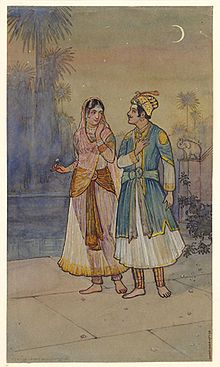Mulboos khas was a special kind of mulmul cloth made for the King and used for Royal clothing in the Mughal Empire. The Mulboos khas was a kind of first-grade muslin exclusively manufactured in Royal Karkhanas (''Mulboos khas kootees''[1]: 160 [2]) notedly in places like Dacca, Sonargaon, Jangalbaree. Nur Jahan, the empress, was a great admirer of Dacca muslins. Mulboos khas was the finest and most expensive type of muslin, and it was used exclusively in Imperial use.[3]

History
editMulboos Khas was an item of gift exchanged between the emperors and nobles.[4] Murshid Quli Khan who was the first Nawab of Bengal was used to send Mulboos khas to Aurangzeb.[1]: 161 [2][5]
It was also sent to Delhi for the Royal use.[6]: 73
The contemporary quality was "Sarkar-i-Ali," which was used for lower hierarchy.[3]
Characteristics
editMulboos khas was a piece material with 10 yards X 1-yard dimensions when produced of half-length. It was having 1800-1900 threads in warp. "Malmal khas" was the successor of Mulbool khas.[3]
See also
editReferences
edit- ^ a b Mitra, Debendra Bijoy (1978). The Cotton Weavers of Bengal, 1757-1833. Firma KLM. ISBN 978-0-8364-0164-6.
- ^ a b Tchitcherov, Alexander I.; Danemanis, Don (1998). India: Changing Economic Structure in the Sixteenth to Eighteenth Centuries : Outline History of Crafts and Trade. Manohar Publishers and Distributors. p. 191. ISBN 978-81-7304-062-7.
They were included in the nuzzur , the yearly offering of the Nawab of Bengal to the Mughal Emperor . The cloth was called mulboos khas , the buildings housing the workshops , mulboos khas kootee
- ^ a b c Chaudhury, Sushil (2020-03-10). Spinning Yarns: Bengal Textile Industry in the Backdrop of John Taylor's Report on 'Dacca Cloth Production' (1801). Routledge. ISBN 978-1-000-07920-3.
- ^ Sarkar, Jagadish Narayan (1987). Mughal Economy: Organization and Working. Naya Prokash. p. 86. ISBN 978-81-85109-47-3.
- ^ Special Exhibition on Textile Traditions of South Asia (past & Present): An Exhibition of Textiles from SAARC Countries, 7 December, 2007 to 6 March, 2008. National Handicrafts & Handlooms Museum, Ministry of Textiles, Government of India. 2007. p. 7.
- ^ Watson, John Forbes (1867). The Textile Manufactures and the Costumes of the People of India. Allen.